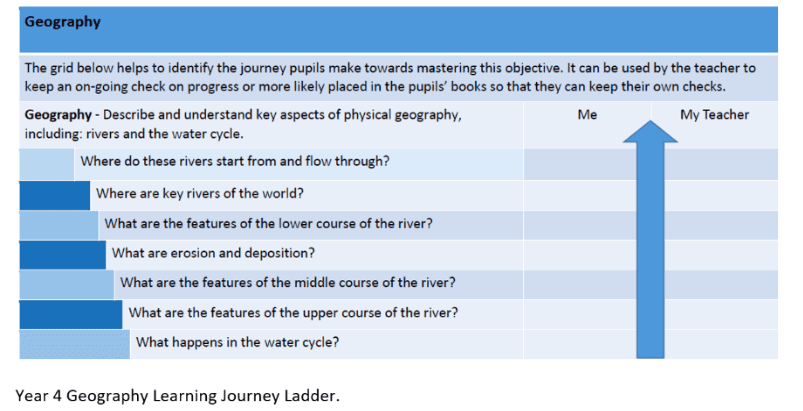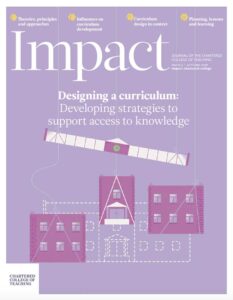Planning for deep learning across the curriculum

Since the introduction of the new National Curriculum in 2014, our school’s aim has been to design a curriculum that meets the needs of the students at our school, is broad and balanced, and is engaging for all. In order to do this we have carried out research by attending courses and reading widely around the subject, trialled strategies in some classes across school to compare impact and reviewed our practice regularly. Although our curriculum will constantly evolve, we feel that we have made huge strides towards achieving a curriculum that meets our initial aims.
Initial curriculum designs were, in hindsight, not planned out effectively enough and did not fully enable our students to have a real depth of knowledge across the curriculum. Following the first set of results under the new assessment system (Combined Reading, Writing, Maths = 57%, High score = 2%; Reading – Expected standard = 75%, High score = 8%; Maths – expected standard = 69%, high score = 10%), we realised a total revamp was needed, with a fresh approach. What also became apparent was that changing the curriculum alone was not the answer; we had to consider the concept of ‘mastery learning’, which ‘breaks subject matter and learning content into units with clearly specified objectives which are pursued until they are achieved’ (Education Endowment Foundation, 2018), what this means to pedagogy and teachers’ attitudes and embrace the expectation that almost all pupils can achieve at least age-related expectations.
The emphasis on books and reading for pleasure, as cited in the National Curriculum 2014, alongside the requirement for students to read ‘beyond the lines’ as outlined in the first new style reading SAT, led us to begin with reading as our driver for our curriculum design. Quality books — those that are well written, have a range of effective vocabulary and interesting plots — were chosen that would engage the students and, where possible, allow us to make links with other subject areas. This includes a balance of current literature, classics, alongside poems and with picture books still being a large part of the Key Stage 2 curriculum too. Finding the right text will be an ongoing feature of our curriculum design, reviewing their impact each year by analysing the quality of work, the children’s engagement with the text through discussions and through data analysis.
It was the total review of our maths curriculum, however that has led to the greatest change to our whole curriculum approach. A ‘bought in’ maths planning frame (Focus Maths, a resource created by Focus Education) — not a scheme, but a system for showing the steps children need to go through to achieve mastery of each objectives and for demonstrating, through exemplar questions, the standards expected of each objective — turned our maths results around within a year, not just in Year 6 but across school, achieving 92% expected, 37% high score for maths in 2017, increasing further in 2018, a huge improvement on 2016 results. This proved the impact that could be had by following the same approach of pre-learning tasks and clear learning journeys as explained below, within other subject areas.
The premise of the design of the maths curriculum was then used, introduced gradually — not all subjects at once — for most other subject areas. The use of pre-learning tasks are the basis for planning for student’s next steps, this is supported by the EEF document ‘Improving Literacy in Key Stage 2’ (Education Endowment Foundation , 2017) in which they state, ‘Diagnostic Assessment makes teaching more efficient by ensuring that effort is not wasted on rehearsing content or skills that a pupil already knows well.’ (p.5)
Pre-learning tasks take different forms depending on the subject but are currently used in maths, science, geography and history. These tasks allow for the teacher to find out what each student knows and then pitch their lessons accurately, with students all working on the same objective at the same time but possibly by accessing different tasks or levels of support dependent upon their prior knowledge. Differentiated input is used, when appropriate, to ensure that students are given new knowledge and / or skills and information when they are ready and are provided with support if needed.
Following the completion of a unit of work a post-learning task is carried out, this is usually the same task that was carried out for the pre-learning task and allows the teachers to assess how much progress each student has made and what knowledge and understanding each student has that they didn’t have before.
When planning for learning to take place, ‘Learning Journeys’ are created in the form of ladders which set out the objectives and expectations needed to be met in order to master the overall objective.

These form our daily assessment of each of the subjects they are used in: currently maths, English, science, geography, history, DT and art. It enables the students to understand the journey they will take to achieve an objective and enables teachers to use Assessment for LearningKnown as AfL for short, and also known as formative assessme... More to plan for next steps as they can see which elements are not fully met, as well as enabling self-assessment to take place, as students reflect on whether they feel that they have successfully mastered an objective. This is the only assessment information we gather, as these ladders, combined with the pre- and post- learning tasks, provides the teachers with all the information that they need about a student’s progress and achievements within a unit of work.
The impact of the strategies shared above has been clearly evident, not only in the increase in data across school, but more importantly in the quality and depth of work being completed by the children. Teacher workload has also been reduced as assessment documents are part of the planning process and are not an add-on creating additional work. With this increased knowledge, I feel very comfortable sending my Year 6 students on to high school knowing that they are truly secondary ready, across all curriculum areas, not just able to pass a SATs paper.










